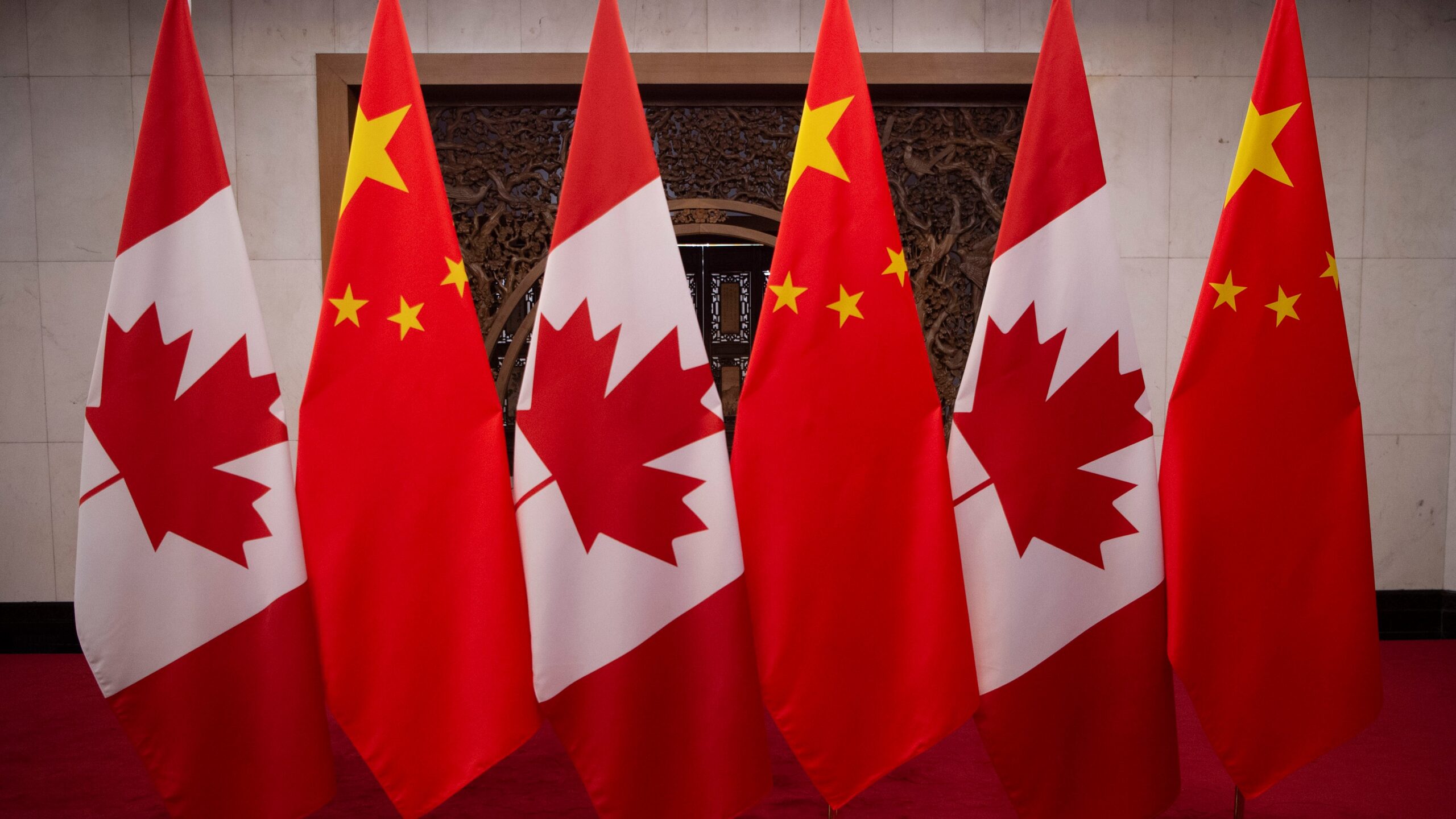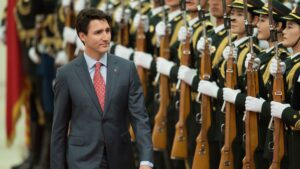
Canada may be moving to become more forceful in the Indo-Pacific, including by pushing back economically against China. (Fred Dufour-Pool/Getty Images)
The announcement of the AUKUS agreement between three of the Five Eyes members sent ripples through the Canadian national security ecosystem, with many asking why Canada was excluded in a new major Pacific security agreement — and others arguing that Canada has not done enough to warrant joining such an agreement. In this op-ed, Stephanie Carvin, an expert on Canadian defense issues, notes that the message may have been received in Ottawa that it’s time to do more.
For many Americans, the announcement that Canada is embarking on the creation of a new Indo-Pacific policy has echoes of the infamous headline “Worthwhile Canadian Initiative,” often considered to be the most boring ever written. After all, what serious country doesn’t produce a foreign policy?
Canada. Canada is that country.
But the idea that Canada is being left behind, especially in the Indo-Pacific, is becoming more palpable. Countries and regions — many without a Pacific coast — are creating their own strategies and setting priorities for the region. As one commentary noted, in a December 2021 speech setting out US policy in the Indo-Pacific, US Secretary of State Tony Blinken named every single regional power, plus countries like Kiribati and Nauru — but not Canada. And the surprise creation of a new Australia-United Kingdom-United States agreement, dubbed AUKUS, came as a shock to Canadians, who watched as three of their Five-Eyes partners moving on in security partnerships without them.
To be fair, Canada hasn’t been totally idle, with the last 12 months seeing a series of political moves from the Trudeau government aimed at a more antagonistic posture towards Beijing. This includes the recognition of the genocide in Xinjiang against the Uighur population by Canada’s Parliament, and new security policies to protect research and prevent foreign control and influence over key sectors of the economy and technology (especially 5G). And in December, the Trudeau government announced that it was following Australia, the United Kingdom and United States in a diplomatic boycott of the Olympic games in Beijing.
RELATED: O No Canada: Is A Three-Eyed AUKUS An Augury For Change?
But aside from these moves, Canada’s interaction vis-à-vis China have been restrained for the last three years, as its allies increasingly took bolder steps in the region. This was due to the situation of Michael Kovrig and Michael Spavor, also known as the “Two Michaels,” who were effectively held as hostages for over 1,000 days to punish Canada for detaining the Chief Financial Officer of Huawei, Meng Wenzhou, on a US warrant. Prior to their Sept. 2021 release, any substantial move made by Ottawa vis-à-vis China would require the government to weigh possible consequences on their well being and prospects for freedom. (Of note, China continues to detain dozens of Canadians, including Uighur activist Huseyin Celil, who receive less media attention and are not the subject of high-stakes negotiations.)
Now, with some pressure from allies, a changing international environment, and the Two Michaels safely home, the Trudeau government has both the need and opportunity to demonstrate — in a concrete, tangible way — that Canada has interests in the Indo-Pacific.
While the strategy is still forthcoming, media reporting suggests that at its heart will be a $3.5 CAD ($2.8 USD) billion effort over five years to shift Canada’s reliance away from China by diversifying trade and investment, as well as boosting security and international assistance in the region. That includes an effort to directly counter China’s Belt and Road Initiative with contributions to development banks, including the Build Back Better World infrastructure partnership, as well as increasing Ottawa’s diplomatic footprint in the region. Even the decision to employ the term “Indo-Pacific” rather than “Asian-Pacific” is telling, adopting a less China-centric term increasingly used by Canada’s allies.
The strategy also reportedly recommends boosting the presence of Canada’s navy in the region, and a greater role in regional cybersecurity. For a country that has not had a large military presence in the Indo-Pacific since the Korean War, this would be a significant shift — even if it only amounts to increased participation in multinational freedom of navigation exercises. (Although it is not yet clear when Canada will have the capacity to do so.)
What is to be made of this new strategy, and why should Canada’s allies care?

Canadian Prime Minister Justin Trudeau views a Chinese military honor guard during a 2017 visit to Beijing. (Lintao Zhang/Getty Images)
First, while seemingly a low bar, just the creation of a document — the setting of goals and outlining the means to achieve it — is a good step. And the expansion of Canada’s diplomatic presence in the region after years of contraction will be a good thing for promoting the country abroad, beyond unfulfilled promises that “Canada’s back.”
However, the cost of the strategy — in a country where Canadians have often balked at the idea of spending money on diplomacy and development — is reason for pause. Will the Canadian public really want money spent on embassies abroad and freedom of navigation, rather than improvements in healthcare in a post-pandemic world? The government will have to explain the value of diplomacy going forward, linking it to the safety and prosperity of Canadians — an argument it was struggled with in the past.
Another question in considering the viability of the strategy is whether the foreign ministry, Global Affairs Canada, is in a position to pull of such an ambitious project after years of cuts, stagnation and poorly organized mergers. Reports suggest that GAC personnel are demoralized, important files are often run by co-op students or new graduates on 90-day contracts, and that it struggles to provide advice to government. A plan to rapidly expand Canada’s Indo-Pacific presence without fixing some of the structural issues at GAC is building a house on a shaky foundation. In this sense, GAC renewal – although likely a much more ambitious and fraught project – is likely a pre-condition to any successful strategy.
Despite the challenges in making an Indo-Pacific strategy a reality, Canada’s allies should welcome the effort. As the great Canadian philosopher Geddy Lee famously said, “If you choose not to decide, you still have made a choice” — and it looks like Canada is thinking about being ready to decide.
The hope is that a country that has long punched below its weight and been too willing to sit on the sidelines can carve out a strategy which supports a free and open Indo-Pacific, but also its own path based on priorities it sets for itself. A formal strategy will signal to Canada’s allies and partners how this might be done together.
Stephanie Carvin is an Associate Professor at Carleton University and a former national security analyst with the government of Canada. She is the author of Stand on Guard: Reassessing Threats to Canada’s National Security (2021) and co-author of Intelligence and Policy Making: The Canadian Experience (2021)
Northrop sees F-16 IVEWS, IBCS as ‘multibillion dollar’ international sales drivers
In addition, CEO Kathy Warden says the company sees a chance to sell up to five Triton UAVs to the NATO alliance.


























